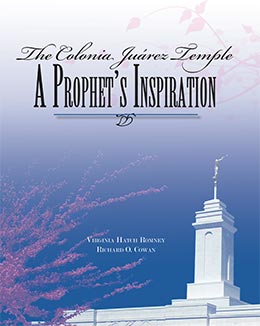Construction Commences
Virginia Hatch Romney and Richard O. Cowan, The Colonia Juárez Temple: A Prophet’s Inspiration (Provo, UT: Religious Studies Center, Brigham Young University, 2009), 43-63.
Monday morning, March 9, 1998, two days after the groundbreaking ceremony, preliminary work started on the ground as heavy equipment began the site preparation. However, significant steps had already been occurring at Church headquarters and elsewhere for some time.
Planning at Church Headquarters and in Mexico
With the announcement of many smaller temples throughout the world, the Temple Construction Department experienced many internal changes. The department, under the management of Keith Stepan, had about 150 architects and engineers on its staff. In order to handle all the upcoming temple construction projects throughout the world, these architects and engineers were organized into three teams—red, white, and blue. Two project administrators headed each team. The white team was chosen to handle Colonia Juárez. Architect Vern L. Martindale and construction engineer Michael Enfield were the project administrators for this team; later, Michael Enfield was replaced by Boyd Erickson. Construction specialist Mark Schaffer was assigned to be the on-site project administrator, and he was to visit often to inspect construction work. His responsibilities included making sure that all issues were resolved according to Church standards and the construction documents. He would make quick decisions to ensure that the project progressed as it should.
Meanwhile, plans for the temple were being prepared. Architect Vern Martindale recalled how, following the visit to the Juárez Academy Centennial, President Gordon B. Hinckley had sketched the floor plan for a small temple with dressing rooms, offices, an endowment room, the celestial room, a sealing room, and a baptismal font, all occupying minimal space. He then autographed his sketch and turned it over to Church architects and engineers.
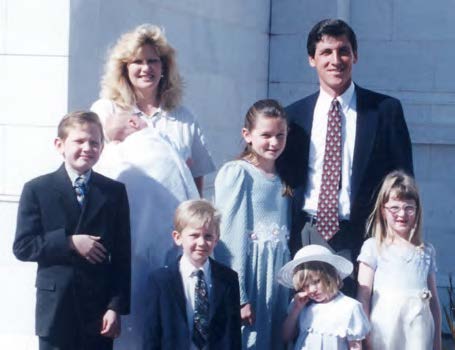 David Wills, his wife Janet, and their children left to right: Adam, Jacob (infant), Spencer, Kali, Nicole, and Kristine.
David Wills, his wife Janet, and their children left to right: Adam, Jacob (infant), Spencer, Kali, Nicole, and Kristine.
Robert Little, manager of this department, drafted a floor plan based on President Hinckley’s drawings. Six or seven Church architects then met and refined the design. An in-house “competition” narrowed these plans to the best four. The best of these was chosen by consensus, refined, and taken to President Hinckley for approval. Once the plan was accepted, architects and engineers began working on the final drawings.
Enfield remarked that the Colonia Juárez temple would be a high-quality temple like any other in the Church. He commented that when a person entered the temple, it would lose its feeling of smallness. He anticipated that the dedication of this particular temple would be very exciting because this was where President Hinckley had received the inspiration for small temples.
Because the temple department would be learning from the construction of the Monticello Utah Temple, this project was pushed forward as quickly as possible. President Hinckley visited the Monticello site several times, as did many others involved in the work, and many changes were made as the construction progressed. The Monticello, Anchorage, and Colonia Juárez temples were the only ones that closely followed the original plan. However, as the Monticello temple was built and went into service, some minor modifications were made in the other two temples. The plan for later small temples had even greater changes. They were expanded to include larger dressing areas, two endowment rooms instead of one, two sealing rooms, reception and snack areas, and a more adequate laundry facility.
Jacobsen Construction of Salt Lake City had already been appointed as contractor for the Monticello temple. In November 1997, they were contracted to build the Colonia Juárez Chihuahua Temple as well. David Wills, an employee of Jacobsen, was assigned to be project manager. His wife, Janet, recorded the following: “David came home from the general conference priesthood session and remarked that smaller temples had been announced. He said he felt that he would be asked to work on one of these temples in Latin America, even though he knew that his employer, Jacobsen, hadn’t been awarded any other temple construction contracts. I felt the same and told him our family would be ready to relocate when the time came. From this point on, prayer and faith became more important in our home than ever before.” A few weeks later David met with Jacobsen’s vice president of operations, and they discussed the company’s interest in building some of the small temples that had been announced. David was told that he would be Jacobsen’s representative if the company was successful in obtaining any of these contracts. “My husband was able to tell them that we had already discussed the possibility,” Janet continued, “and the answer was yes.”
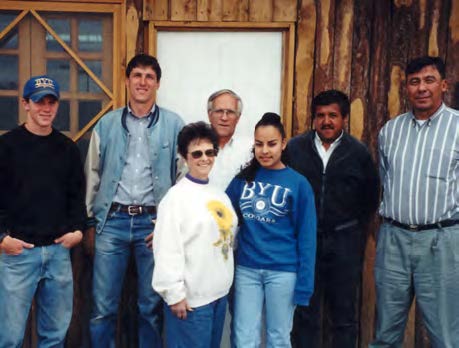 Left to right: construction overseers and office personnel Chad Call, David Wills, Bon Adelle Skidmore, Richard Skidmore, Flor Serrano, Juan Escamilla, and Francisco Lozano.
Left to right: construction overseers and office personnel Chad Call, David Wills, Bon Adelle Skidmore, Richard Skidmore, Flor Serrano, Juan Escamilla, and Francisco Lozano.
In conjunction with Cobaco, a contractor in Mexico recommended by the Church, Jacobsen Construction put together a proposal. In October, David met with Francisco Lozano Lechugo, owner of Cobaco, and a number of others representing this company and the Church. After the contract was finalized, Juan Escamilla became Cobaco’s on-site project manager to supervise their role on a daily basis. Subcontractors were later chosen to handle such matters as plumbing and drainage, heating and air conditioning, electrical equipment, doors and windows, interior walls, and welding.
Wills met regularly with President Meredith Romney of the Colonia Juárez stake and the architect from El Paso, Texas, retained by the Church. He also met with Church architects and engineers in the Temple and Special Projects Department.
“In February 1998,” Sister Wills continued, “we packed what we could fit into a pickup and with our five children in our Taurus wagon headed for Colonia Juárez, Mexico, to live in a two-bedroom home. We were scared and praying constantly to receive the inspiration we would need in the next step of our journey. Our children prayed with us as we passed through Mexican customs and the soldier checkpoints. All in all, it was a faith-building experience for everyone. The Lord truly kept us in His care.”[1]
As the number of small temples under construction increased, the Church assigned experienced couples as on-site small-temple-project missionaries. President Hinckley called Richard and Bon Adelle Skidmore, of Idaho Falls, in September 1998 to work on another temple at Ciudad Juárez. However, since construction on that temple had not yet begun, they were reassigned to help complete the Colonia Juárez Temple. They were to assist project manager David Wills and were called to serve for eighteen months or until the temple was completed.
November 3, 1998, when the Skidmores arrived, was a happy day for David Wills. Elder Skidmore had his own construction company, Skidmore, Inc., in Idaho. He and his wife were a great help. They were told to come and help relieve some of the stress and responsibilities of the project manager by picking up the loose ends. They were to assist in quality and traffic control, scheduling, record maintenance, and accounting. The Skidmores were part of the first group of missionaries to go through training in Salt Lake City for this kind of assignment and were the first missionary couple to see a temple to completion.
When the temple was announced in October 1997, high school student Chad Call had just begun his senior year at the academy. He decided that after graduation he would stay to work on the temple until it was finished instead of going away to work or attend college. At the time he was only seventeen and would not reach missionary age for two years. As soon as school was out in May 1998, Chad was hired and became an assistant to David. He proved to be a very valuable employee. There were many days when David was out of town and Chad was in charge, quite an undertaking for an eighteen-year-old. Elder Skidmore recognized in Chad a very mature young man with great intelligence and learning capacity beyond his years. Many times he went to Chad for advice or information.[2]
Construction Gets under Way
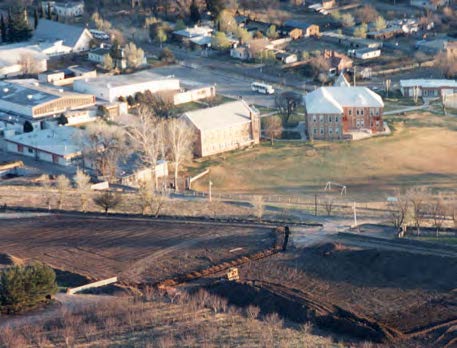 Above: Temple site with academy and town in background, March 19, 1998. Courtesy of Marvin Longhurst. Below: Temple footprint and foundation work, May 1998. Courtesy of Marvin Longhurst.
Above: Temple site with academy and town in background, March 19, 1998. Courtesy of Marvin Longhurst. Below: Temple footprint and foundation work, May 1998. Courtesy of Marvin Longhurst.
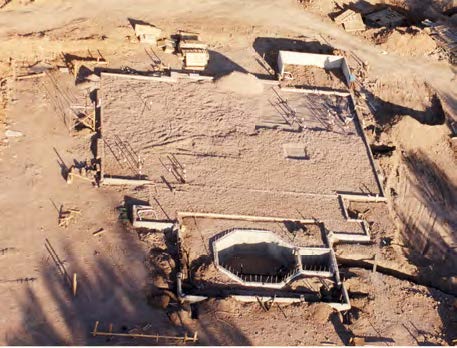
The first month was spent clearing the land and working the ground. The temple site, located on a hillside west of the academy campus, was very uneven and rocky, with little good soil. As a result, truckloads of rocks were hauled away and truckloads of topsoil were brought in. The entire site had to be built up and leveled. On April 13, after the land was cleared, grading for the building pad began. This process required seven layers of soil to be put down and compacted, the last being completed on May 1. The temple’s footprint was then outlined on the building pad, and excavation for the footings and foundations on the main part of the structure began on May 4. Three days later, excavation began for the baptismal font. Within the next four weeks, the concrete footings and foundations were poured.
When school was out at the end of the month, sixteen-year-old Quincy Robinson went to work on the project. “Working up at the temple for me was a great experience,” he reflected. “I became more appreciative of the work that is needed to build a temple. The knowledge that I was working on the temple and the knowledge of what would be done within its walls helped me want to work hard on all the jobs I was assigned.”[3]
Meanwhile, work on the parking lot began on May 21 as sand and gravel were hauled in. By September 8, Cobaco had poured nearly seven thousand square feet of concrete for the parking lot slab.
At the same time, the temple began to take shape. Structural columns and trusses were being welded. By July 28, crews had finished the steel stud framing of the exterior walls and were beginning work on the interior. Scaffolding was being constructed, and the aluminum-clad plywood was beginning to give the building a more definite form.
Normally weather was favorable for the construction to move ahead, but during the spring there had been occasional strong windstorms and several chilly, dreary days to contend with. That summer a very unusual storm with wind, rain, and hail swept over Colonia Juárez, leaving the temple site completely flooded. Several of the metal frame studs were blown over and had to be replaced. Summer rains would come and go, but the builders donned yellow raincoats and continued their work.
David Wills wanted this to be the people’s temple and was very congenial to members and visitors as they came to visit. However, he always cautioned everyone to be very careful when they were on the site. The weekend night watchman, Porfirio Ruíz, and his wife, Carmen, looked forward to their time together at the temple site. They were not members of the Church and were pleasantly surprised by the way visitors and workers acted and expressed themselves. The Saints visiting the site remarked what a great blessing the temple would be. Some members lamented that they weren’t then worthy to enter. Everyone wanted to take home a recuerdo (memory or keepsake), whether a piece of discarded marble or a photograph. Carmen expressed that this had been a new wonderful experience; seeing so many enthusiastic members of the Church had given them much happiness.[4]
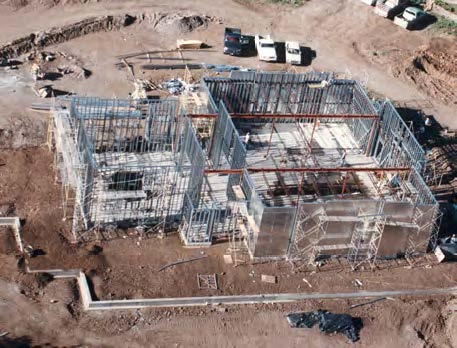 The temple taking shape, July 28, 1998. Courtesy of Marvin Longhurst.
The temple taking shape, July 28, 1998. Courtesy of Marvin Longhurst.
Industrial Rio Conchos of Ciudad Juárez, who had provided and assembled the heavy steel crossbeams and trusses, also installed the roof covering. On August 19, scaffolding for the tower was set up and two weeks later, the first steel studs on the tower were welded into the base for plywood support. By September 8, the roof decking was nearly complete.
Cobaco subcontracted Jay B. Whetten, who owned his own welding shop, Troqueladora Sierra Madre, in Colonia Juárez, to do welding jobs around the site. After the beams of the roof were in place, his crew began welding the exterior metal framing and tower.
By the last week of September, all underground utilities, including telephone, water, and gas, had been installed. The parking lot and stud wall framing had also been completed. On average, there were about forty-five men working at the site on any given day.
On September 8, a crew of eleven began installing the exterior marble, starting on the west side of the temple. This marble was quarried in the Mexican state of Durango. The Temple Construction Department examined a sample of this marble and praised it for its uniform color and texture. However, the quality of the marble actually shipped did not meet the specifications or quality of the samples, nor did the crews properly place it. Therefore, much of it had to be returned, and new crews were employed to install it properly.
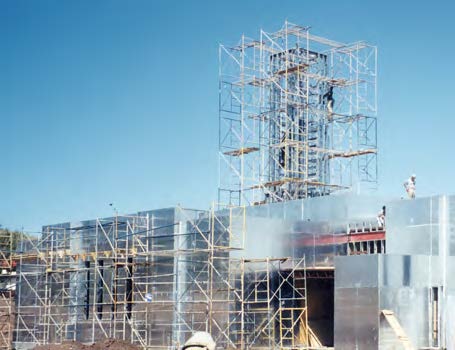 Aluminum-clad plywood forming the temple’s exterior in September 1998.
Aluminum-clad plywood forming the temple’s exterior in September 1998.
The marble was cut and polished at La Torena, a factory in Durango. At one point the marble supply was cut off, halting work on the temple. Help came from colony natives Paul Bowman and Dennis Wagner, who owned Quarry Direct, a stone-installation company in Utah. Paul persuaded his associates at La Torena to give the temple builders preferential treatment, making it possible to get the needed marble for the temple.
October 3 was an exciting day when the shipment containing the statue of the angel Moroni, baptismal font, twelve oxen, and window glass arrived. These items were stored in Colonia Juárez resident Jasper McClellan’s garage, and he joked about keeping very busy feeding the oxen night and morning. Later, when the angel Moroni was taken out to be placed on the tower, McClellan said that his best helper was gone, leaving the care and feeding up to him now.[5] By the middle of October, insulation batting was being placed within the framed walls, and sheetrocking had commenced in the endowment room.
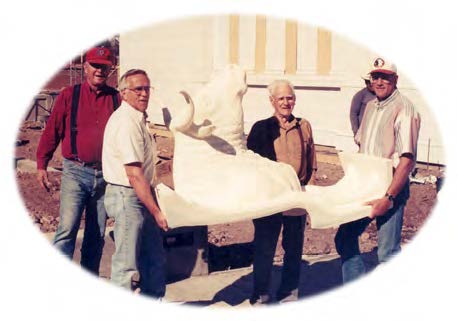 Left to right: Howard Schmidt, Elder Richard Skidmore, Jasper McClellan, and Ron Dalene carrying one of the oxen for the baptismal font.
Left to right: Howard Schmidt, Elder Richard Skidmore, Jasper McClellan, and Ron Dalene carrying one of the oxen for the baptismal font.
As much as possible, the Church tried to use local materials, technology, and people to work on the construction so that it could be their temple. However, this posed many challenges. Several companies owned by colony residents or former residents were subcontracted for different projects. During one of his visits, Michael Enfield saw that some crews were having a difficult time staying on schedule. He told them in a positive way that the Church wanted them to be successful and wanted to help. These were very encouraging and timely words. In mid-November, for example, the drywall installation was behind schedule. Six drywallers from Standard Drywall, Inc., came from Salt Lake City to help them catch up.
Adam Hatch, a twenty-two-year-old returned missionary, volunteered to help on the temple: “I was asked to oversee the remaining concrete work on the temple site. The job turned out to be a little more than I had anticipated, and I needed some good help.” He therefore recruited two other recently returned missionaries, Jay Nielsen and Benjamin Quintana, to help. In addition, four masons from Nuevo Casas Grandes and three others joined the crew. They began work on the retaining wall on November 16 and finished it by the end of the year. They then worked on the road leading up the hillside from the school parking lot.
When additional help was needed, Adam turned to his uncle and former employer, Rhett Bowman, a former Dublán resident who was the founder of Bowman Brothers Concrete, a large firm based in Mesa, Arizona. One of Rhett’s specialties was architectural cement work. He put together a crew of several employees from Arizona and some former employees from Mexico who donated their time. Rhett paid the employees out of his own pocket.[6] They were able to complete the work in only three weeks. The last thing they did was pouring all of the sidewalks with decorative patterns, stairs, and borders for the grass. Max Spilsbury, Greg Hatch, and Kevin Schmidt, three other recently returned missionaries, also helped with the construction.
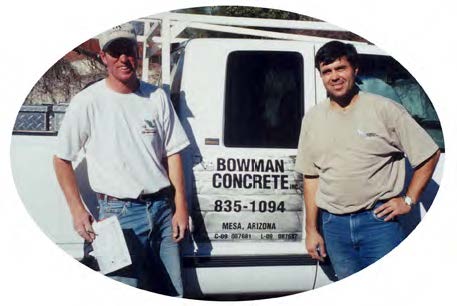 Adam Hatch and uncle Rhett Bowman, a cement contractor from Arizona who came to help.
Adam Hatch and uncle Rhett Bowman, a cement contractor from Arizona who came to help.
Other young men waiting for mission calls also found great joy in working on the temple and its grounds. Adam Spilsbury and Dustin Romney spent time helping out. Brandon Romney and Randall Hatch worked at the temple until the week they left for their missions. Brandon said he thoroughly enjoyed working on the temple for two months prior to leaving for England: “I think that it was the best thing that I could have done while waiting to go on my mission. It gave me something to think about, and it made the time pass by very quickly. I was very happy to have a hand in building the Lord’s house.”[7]
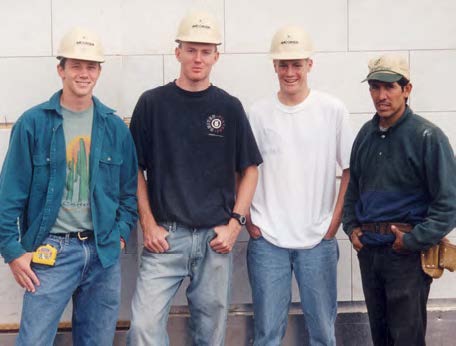 Left to right: Chad Call, Brandon Romney, Quincy Robinson, and Israel Guzman played key roles in the temple’s construction.
Left to right: Chad Call, Brandon Romney, Quincy Robinson, and Israel Guzman played key roles in the temple’s construction.
Interior carpentry work started on December 1, beginning with the moldings in the endowment room. Originally, four carpenters came from Salt Lake City and California. Church member Marco Antonio Avalos from Contempo Cabinet Company remained until the end of January. Crossroad Mill of Draper, Utah, supplied all of the moldings. Israel Guzman of the Lomás Ward started out as part of the Cobaco crew, but his interest in the work and desire to learn soon became apparent, and he was promoted to work with Marco as a carpenter’s assistant. As a result, he became very accomplished in several areas of construction. “I have been here since the beginning,” Israel reflected. “I know that each place in the temple is very special, from the landscape to the celestial room. Great blessings await those who worthily enter therein.”[8]
Working in the celestial room was a special experience. Work on the ceiling and decorative columns had begun by early October. By mid-November, the window frames were installed. In December, Ron Dalene from Colonia Juárez volunteered to help with carpentry and other facets of the construction. “When I went to help the carpenters install the moldings in the celestial room, Brother David Wills told us that we needed to do a perfect job. He said that of all the places in the temple, the celestial room had to be the most perfect because it represented the celestial kingdom. The celestial room is the place where people come to meditate, pray, and get closer to their Father in Heaven. There is no room for mistakes or flaws that will distract people in their desires to get close to our Heavenly Father. His words made an impact on all of us and motivated us to try harder with our workmanship and to do better than our best.”[9]
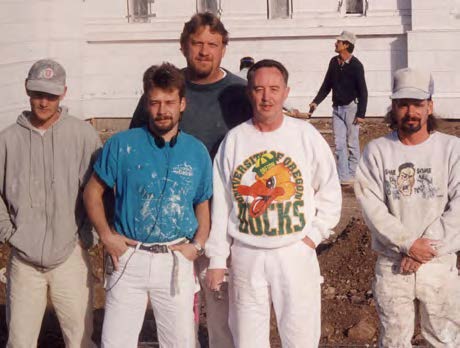 Michael Funk, behind, and his crew, left to right: Chuck Taylor, Shane Hunsaker, Brent Hansen, and James Carpenter from Professional Painting, Inc., in Salt Lake City
Michael Funk, behind, and his crew, left to right: Chuck Taylor, Shane Hunsaker, Brent Hansen, and James Carpenter from Professional Painting, Inc., in Salt Lake City
A crew of five professional painters from Salt Lake City started working inside the temple on December 7. Michael Funk was the crew manager. They were responsible for preparing the wood surface by sanding, applying wood filling, and painting until it shone like glass. They prepared the walls for their coverings. Each crew member put in at least seventy hours a week. The crew returned to Utah for Christmas and was already back on the job in Mexico by December 29. By the time they left on January 15, eight to twelve coats of paint had been applied. Mike the Painter, as he was affectionately known, reflected on his experience: “Decorating or redecorating temples gives me a great sense of pride. It is so good to meet people as they come to visit the temple. Here I get a lot of handshakes and hugs, abrazos, as you call it. I have never seen local Church members get so excited and involved in building a temple as I have here. It is touching to see everyone so excited and involved.”[10]
Landscaping
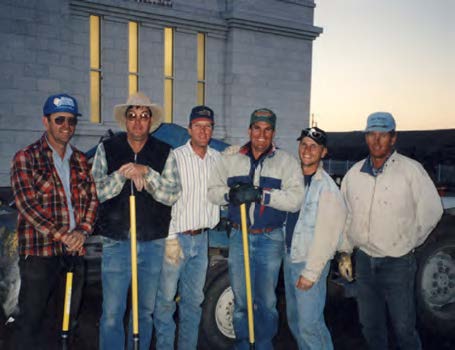 Members of the hardworking landscape committee including, left to right: Marvin Longhurst, Gerald Hatch, Dana Call, Lester Johnson, Brad Turley, and Fred Hatch (committee chairman Philip Taylor absent).
Members of the hardworking landscape committee including, left to right: Marvin Longhurst, Gerald Hatch, Dana Call, Lester Johnson, Brad Turley, and Fred Hatch (committee chairman Philip Taylor absent).
While construction was progressing on the temple itself, work was also moving forward on landscaping the site. In November 1997, about a month and a half after the Colonia Juárez temple had been announced, Mark Williams, the Church’s landscape architect, called Philip Taylor, an experienced horticulturalist in Colonia Juárez, to ask about plants that would grow in the area. Taylor prepared a list and sent it to Salt Lake City. He recalled what happened a few months later: “In early spring 1998, David Wills approached me and said that because of the unique situation in which we lived, the Church had decided to allow the members of the two stakes to be involved with the building of the temple. It had been decided that we would be in charge of doing all the landscaping. He told me that I had been recommended to oversee this work. A set of plans was delivered to me, and David made suggestions as to timetables when different projects should be completed.”[11]
Taylor was able to identify sources for all the plant materials he needed except one. “No nursery had grass available for when we were supposed to install it. The only option was to plant our own.”[12] Three acres of land adjacent to Taylor’s orchard, up the river from Colonia Juárez, was identified as having the same basic soil type that the temple grounds had. Grass would be planted there, and then the sod would be moved to the temple grounds later. With the help of the members of both stakes, the land was prepared. Tons and tons of rock were hauled off. The area was tilled, raked by hand, leveled, fertilized, sprayed, then tilled and raked again, then planted. After the grass came up, the work continued in mowing, watering, fertilizing, and spreading mulch. Thousands of hours of service were donated by the members in getting the grass ready to plant down at the temple site.
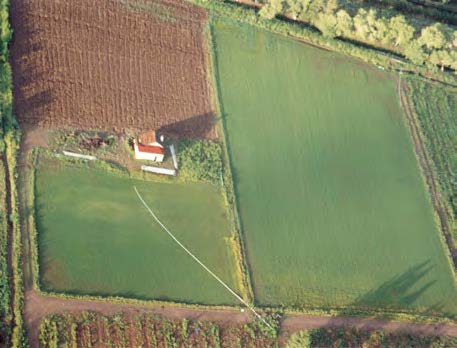 Grass was planted around June 20 in a field offsite in preparation for use at the temple. Courtesy of Marvin Longhurst.
Grass was planted around June 20 in a field offsite in preparation for use at the temple. Courtesy of Marvin Longhurst.
On October 13 the first of thirty-nine truckloads of semi-decomposed sawdust arrived from the old abandoned Apache sawmill west of Valle Grande in the mountains. Several of these loads of mulch were delivered where the sod had been planted. The rest of them were delivered to the temple site. Local members donated trucks, drivers, or cash to accomplish this. Kent Romney and Fred and Herman Hatch organized and saw this project to completion. During the following days, academy students were taken to the sod fields in schoolbuses to spread the mulch.
While the sod was being prepared, other landscaping projects also needed to be accomplished. By the last week of September, landscaping material arrived and six-foot-deep holes were dug for trees. In mid-October, Jay B. Whetten’s metalworking company began installing the fence and gates around the site. In November, installation of the sprinker system began.
To keep the landscape work on track, Philip Taylor set up a schedule for wards from both stakes to come and help. The wards called it their ward temple workday. The first was on December 21, and workdays continued almost daily for the next three weeks. Thereafter, whenever the need arose, a ward was advised on Sunday of an upcoming temple day, and old and young faithfully responded to the call. Individuals and families considered it a wonderful blessing and opportunity. Ward and stake Young Men, Young Women, and Primary groups built their activities around these temple days, but many came on other days also.
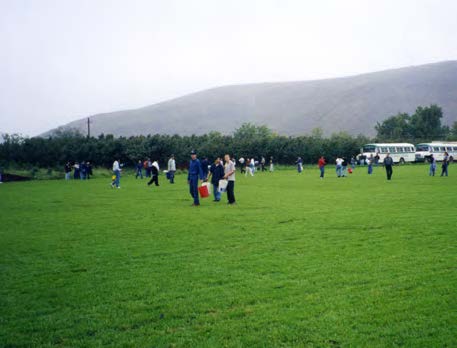 Academy students participated in preparing sod for use at the temple.
Academy students participated in preparing sod for use at the temple.
Near the end of December, it was obvious that the landscaping would not be finished on time, so additional help was urgently needed. On December 27, Bishop Fredrick Turley of the Juárez First Ward assigned his counselor Dana Call to mobilize brethren to meet the emergency. Thereafter, many of them were on the site from dawn until dusk. Others came when they could. They all left their orchards and other responsibilities to help meet the February 15 deadline, a predetermined date for the completion of the temple. Dana reported that many donated equipment, their own hired help, and money to pay for fuel and maintenance of the equipment. This equipment included excavators, roadgraders, bulldozers, backhoes, dumptrucks, tractors, rippers, tillers, dump wagons, levelers, loaders, fertilizer spreaders, and a semitrailer truck.
As members worked on the landscaping, in frustration they often wondered, “Where did all these rocks come from? You rake up one, and two more grow back in its place.” Wheelbarrows and trailers filled with rocks were hauled away. “There was always plenty to do when members arrived,” Dana explained. “Jobs included removing subsoil; hauling in topsoil to replace it; screening existing topsoil to get the many rocks out; removing construction debris; adding mulch; tilling; leveling; digging and covering irrigation line trenches; endlessly raking rocks; fertilizing; planting trees and shrubs; cutting, hauling, and laying the sod; irrigating; sweeping the parking lot or concrete sidewalks; and sanding the fence. It has been an all-out effort with much help from many people, and the result has truly been near perfection as would suit the house of the Lord.”[13]
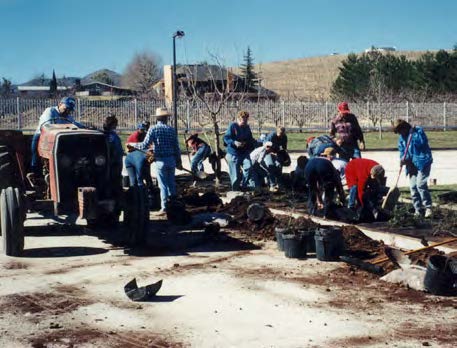 Members were called on spur of the moment to come help plant the first shrubs on January 28.
Members were called on spur of the moment to come help plant the first shrubs on January 28.
About 170 members of the Dublán and Juárez First Wards worked together on December 23. “There was a cold wind blowing and dust flying everywhere, but this didn’t hinder the work. The general feeling of the day was: ‘If the pioneers could build the Salt Lake Temple under the extreme difficult circumstances of their time, then the sore muscles, blisters, and discomforts of this day could certainly be endured for the great blessing of a temple.’ It was always a touching scene to see so many working so hard together, day after day, week after week, in a variety of activities.”[14]
The Angel Moroni
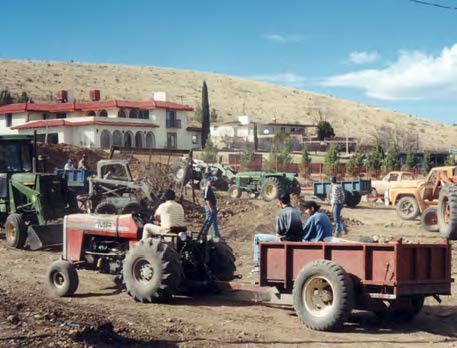 Members donate time and equipment for the temple.
Members donate time and equipment for the temple.
Gold-leafed statues of the angel Moroni are a familiar feature atop the towers of Latter-day Saint temples. Therefore, placing the angel is an eagerly anticipated milestone signifying the completion of a major phase in a temple’s construction. This herald sounding a trumpet is seen as a fulfillment of John’s vision: “I saw another angel fly in the midst of heaven, having the everlasting gospel to preach unto them that dwell on the earth, and to every nation, and kindred, and tongue, and people, Saying with a loud voice, Fear God, and give glory to him; for the hour of his judgment is come: and worship him that made heaven, and earth, and the sea, and the fountains of waters” (Revelation 14:6–7). Specifically, Moroni was the last prophet and historian who compiled the ancient history which became the Book of Mormon. Because the book’s announced mission is to convince “Jew and Gentile that Jesus is the Christ” (Book of Mormon title page), this angelic figure symbolizes heralding the latter-day Restoration of the gospel in preparation for the Second Coming of the Lord.
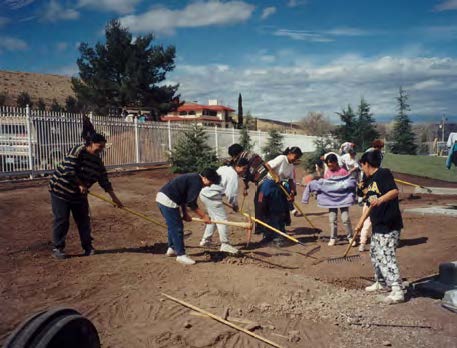 Members from Laguna Ward raking and removing rocks.
Members from Laguna Ward raking and removing rocks.
The original plan for the small temples was to depart from the traditional golden figure of Moroni. A newly designed white statue of the angel holding a trumpet in his right hand and a scroll in his left was placed atop the Monticello Utah Temple on May 14, 1998. Similarly, the architect’s rendering of the Colonia Juárez temple showed a white statue.
Construction specialist Mark Schaffer arrived December 16 from Salt Lake City and had to leave the following day. He had helped install the angel Moroni figure on the Monticello temple, so his experience would be valuable. The steel base for the statue had already been installed on the Colonia Juárez temple’s tower on November 14.
Because the date for the placing of the angel was rushed to fit Mark Schaffer’s tight schedule, word didn’t get circulated to the local Saints as much as Dave Wills would have liked. Fortunately, there was a band concert at the academy the night before, which enabled a lot of people to hear about the event, but there would have been a better turnout if it had been announced during Sunday services. Nevertheless, over six hundred people witnessed the event. Thursday, December 17, 1998, dawned crisp and clear. This was the day that the angel Moroni would come out of storage in Jasper McClellan’s garage and take its rightful place as sentinel over the valley of Colonia Juárez. Pilots Marvin Longhurst and Dave Jones, in separate planes, were enjoying a privileged view. Dave Wills and Chad Call had made a midnight trip to the McClellan garage the previous evening to prepare the angel for its ascent. They wanted it wrapped for its protection on the trip up the tower.
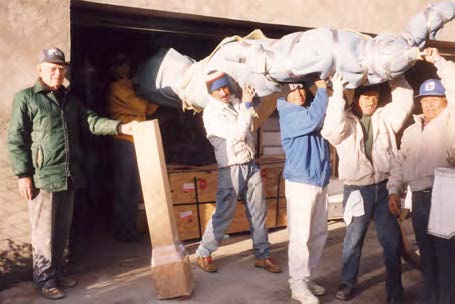 Jasper McClellan holds the box containing the trumpet as crew members carry the angel.
Jasper McClellan holds the box containing the trumpet as crew members carry the angel.
The students from the academy and the Juárez grade school were released from classes for the occasion, and the Dublán grade school was out for Christmas vacation, enabling their students—future Church leaders—to be there in force.
As people gathered in groups to watch, the figure, wrapped in a blue covering, began its slow ascent at 9:10 a.m. Having no crane, the heavy statue was lifted and pushed upward with great effort by workmen on the scaffolding. As a privileged few on top of the tower unwrapped the first layer, people below still calmly visited and enjoyed the event, but as the second layer came off, there were exclamations of awe and clapping. The words “He’s gold, he’s gold! I thought he was going to be white,” could be heard again and again. “He’s beautiful!” Observers felt that President Hinckley’s love for them was evident.[15]
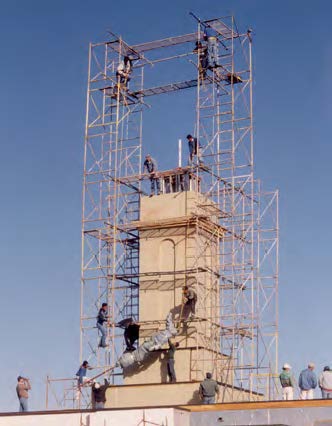 With no crane to assist them, workmen hoist the wrapped angel to the top of the temple’s tower
With no crane to assist them, workmen hoist the wrapped angel to the top of the temple’s tower
David Wills, Chad Call, and Brandon Romney were the only ones in the area who had known that the angel was gold. For months they kept it a total secret so that everyone would be surprised. Afterward, Dave said that keeping this secret had been his best trick but that he had no more secrets.
Mark Schaffer explained that when President Hinckley had seen the white angel Moroni atop the Monticello temple on July 6, just before the temple’s dedication, he wanted to go back to the traditional gold angel. The small temple angels are younger-looking angels instead of the older traditional ones on the larger temples. The Colonia Juárez angel is seven feet tall, mounted on a two-foot stand. The tip of the angel’s trumpet is the highest point on the temple.
David Wills had worried that the angel base rod would not fit correctly into the base, but it slipped right in. He said that the angel placement had been the easiest part of the temple construction so far, and he was very relieved that it all went so smoothly. Chad Call and Antonio Venzor were the last ones on top of the tower, and they completed the final step of the placement by inserting a lightning rod down the center of the figure.
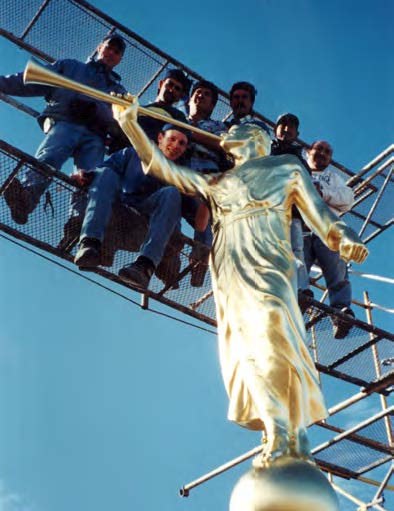
Emotions were high as the crowd witnessed this momentous occasion. Within seconds of unveiling the angel, a group of sixth graders, without adult prompting, began singing softly “Me Encanta Ver el Templo” (“I Love to See the Temple”). Others were drying their tears, still unable to believe how beautiful the gold angel was.
A group of high school boys said they felt a good spirit present, a sense of unity, remarking that the angel and the temple were “just awesome.” Ismael Acosta of the Nuevo Casas Grandes First Ward said that being there was a once-in-a-lifetime experience.[16]
Domitila Quintana of the Juárez Second Ward, through tears and with a choked-up voice, said that as the angel was unveiled, standing straight and tall, she felt something very special—as though the angel were watching over everyone now and in the future.
Pedro de la Cruz of the Huertas Ward said the angel was just beautiful, so pretty and big, adding, “Nuestro México florece” (“Our Mexico flourishes”).
Cecilia Alvarez, a nonmember friend of Martha Jaidar of the Dublan Second Ward, was present that day. She felt the Spirit so strongly that she told Martha, “I am so excited. I can imagine how all of you must feel.”[17]
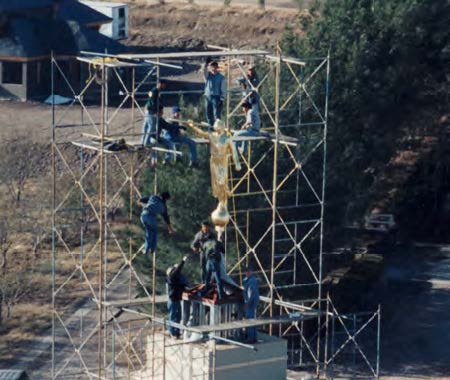 The angel Moroni statue fit perfectly on the temple’s tower. Courtesy of Marvin Longhurst.
The angel Moroni statue fit perfectly on the temple’s tower. Courtesy of Marvin Longhurst.
Aaron Chavez of the Villa Hermosa Ward, a Juárez Academy seminary teacher, said, “I think we are seeing a little of what John the Revelator, a long time ago, saw when he saw an angel fly in the heavens. Today I feel a little of the emotion of the fulfillment of this prophecy.”
Temple carpenter Israel Guzman, who had just come down from the tower, said it had been such a privilege to be involved in the unveiling. He felt that those present were seeing the fruits of all the sacrifice and dedication of the early local pioneers and also the fruits of the faithful local members of the Church throughout the decades. Perhaps five-year-old Makenzie Call of the Juárez First Ward said it best: “I feel very happy. I like it a lot. I know the angel Moroni was supposed to go on today.”[18]
Now that the angel Moroni was in place, attention turned to finishing the temple within the next two months.
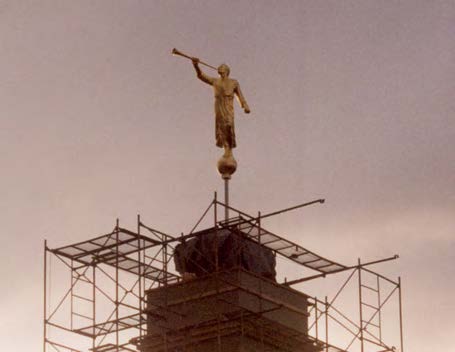 Thursday, December 17, 1998, the day the angel Moroni was placed on the tower, marked a significant milestone in the temple’s construction.
Thursday, December 17, 1998, the day the angel Moroni was placed on the tower, marked a significant milestone in the temple’s construction.
1998
Mar. 7: Ground broken by Area President Elder Eran A. Call
Apr. 13: Grading and leveling of site completed
May 4: Excavation for foundations and baptismal font begun
May 26: Footings completed and foundation walls poured
July 28: Steel studs for exterior walls in place
Sept. 8: Roof deck nearly completed; first exterior marble installed; electrical conduits being installed
Sept. 30: Ventilation ducts being installed; underground utilities and parking lot completed
Nov. 14: Sheetrock being installed
Dec. 1: Painting of temple interior began
Dec. 17: Angel Moroni placed on temple’s tower
Dec. 21: First ward temple day
Dec. 22: Baptismal font brought into the temple
1999
Jan. 6: Windows and doors installed; heat turned on
Jan. 18: Carpet laying in celestial room started
Jan. 26: Crystals hung on celestial room chandelier
Jan. 28: Sod that members had cultivated brought to temple grounds
Feb. 6: Youth cleaning exterior marble; scaffolding removed
Feb. 8–12: Telephone system and other technical equipment installed; seats installed in ordinance room; other furnishings brought in
Feb. 15: Final inspection by men from Temple Construction Department
Feb. 24: Completed temple turned over to the Church
Feb. 25–27: Open house
Mar. 6–7: Temple dedicated by President Gordon B. Hinckley
Mar. 8: Ordinance work begins
Notes
[1] Janet Wills, in Virginia Romney, History of the Colonia Juárez Chihuahua Temple, 1:111; Unless otherwise noted, statements quoted in this chapter were given to Virginia Romney near the time of the temple’s completion.
[2] Richard Skidmore, in Romney, History, 1:114.
[3] Quincy Robinson, in Romney, History, 1:114.
[4] Romney, History, 1:115.
[5] Romney, History, 1:116.
[6] Rhett Bowman, conversation with Michael Cannon, August 8, 2007.
[7] Brandon Romney, in Romney, History, 1:118.
[8] Israel Guzman, in Romney, History, 1:118.
[9] Ron Dalene, in Romney, History, 1:118.
[10] Michael Funk, in Romney, History, 1:119.
[11] Romney, History, 1:116.
[12] Philip Taylor, in Romney, History, 1:116.
[13] Dana Call, in Romney, History, 1:120.
[14] In Romney, History, 1:120.
[15] In Romney, History, 1:244. Gay Longhurst contributed to this section.
[16] Ismael Acosta, in Romney, History, 1:245.
[17] Cecilia Alvarez, in Romney, History, 1:245.
[18] Makenzie Call, in Romney, History, 1:245.
